
The Flamingo Land Planning Application should be central to the debates currently taken place in the Scottish Parliament on a new planning bill. The central question they need to address is how is it that the Loch Lomond and Trossachs National Park Authority could be judged overall winner in the Scottish Quality Awards for Planning in 2015 for their work on community involvement in their Local Development Plan and yet, just three years later, have received c35,000 objections, many from the local community, for a development that was, partially at least, included in that very same plan. This post takes a look at why basically there were almost NO objections back then and 35,000 now? It follows on from my post which looked at how Flamingo Land’s planning application fits with the Local Development Plan which set out the framework for planning in the National Park (see here).
First a point about the Scottish Quality Awards in Planning and the LLTNPA.
Scottish Quality Awards in Planning and the LLTNPA

The receipt of quality awards plays a central part in the LLTNPA spin machine. Senior staff put forward nominations every year and then when they receive an award use this to convince Board Members and the Scottish Government that they are doing a wonderful job.
As an illustration of this, after my post on the Keltie Water hydro scheme I submitted an FOI request. The response (see here) shows no Board Member was involved in selecting the scheme but the Director of Planning, Stuart Mearns, had visited in 2017. That the Director of Planning thought the Keltie Water scheme merits a planning award is more than worrying. Anyone visiting it with a copy of the Park’s Best Practice Guidance on Renewables – which received another Scottish Award for Planning back in 2014 – could see at at glance that it falls short of those standards. Perhaps though the Director of Planning was just carrying out instructions from on high? What this illustrates is that there is every reason to be sceptical about how far ANY of the LLTNPA’s recent submissions for Quality Awards reflect what is really going on.
Unfortunately the judges of the quality awards appear to have subjected the LLTNPA’s submissions to little critical scrutiny. The LLTNPA was made overall winner in 2015 (see above) for their use of innovative communication techniques, including pretty graphics and social media. Such techniques are all very well but, having been personally impressed, the question the judges should have then asked/checked is how many people knew about this or understood what was really being proposed? Its not difficult to find examples in the responses to the MIR from the public suggesting all might not be well (see above and below):

35,000 objections suggest that the judges gushing conclusion that the project “had, without doubt, set a new pioneering benchmark which others could follow” was maybe just a wee bit off the mark. I don’t blame the judges for this: lots of other people have been fooled by the Park’s spin machine.
The Main Issues Report and Flamingo Land
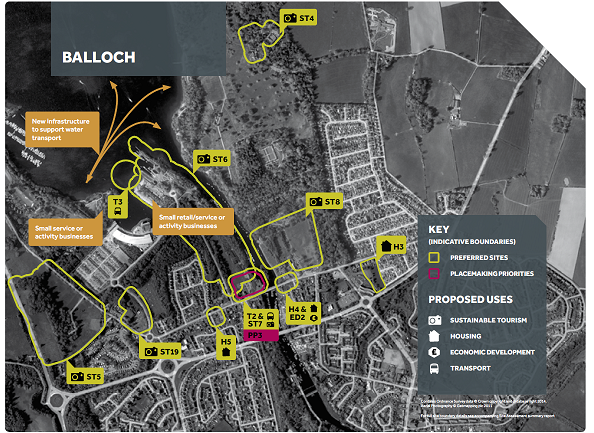
One of the things being considered as part of the Scottish Planning Bill is whether consultation on issues affecting a local area, in the form of a “Main Issues Report”, should still take place before Planning Authorities draft their Local Development Plans for (further) consultation. The LLTNPA consulted on their Main Issues Report in 2014 and published the Verbatim responses in 2015 (see here). I have gone through all the responses for Balloch, including those for the West Riverside Site (ST6 above) and Woodbank House (ST5).
There was not a single response from any individual member of the public to the allocation of land at West Riverside for Sustainable Tourism and the handful of responses came from public agencies:
- The Loch Lomond Steamship Company objected to the failure of the Report to identify Balloch Pier (along with other piers around Loch Lomond) and the Maid of the Loch as being important for Transport and rightly asked why land next door (T3 symbol on map) had been allocated for transport rather than the existing pier
- The Scottish Environment Protection Agency pointed out much of the West Riverside site was on a flood plain and unsuitable for development
- Historic Scotland commented that any development on the West Riverside Site should respect the historic setting of Balloch Pier, steam slipway and engine house
- West Dunbartonshire Council agreed Balloch was a suitable place as a strategic tourism destination
That was it! And now there are c35,000 objections. So what went wrong?
Well part of the explanation is that the land has long been used for leisure/recreation, had been allocated for this in the previous Local Development Plan and therefore people assumed that not much would change.
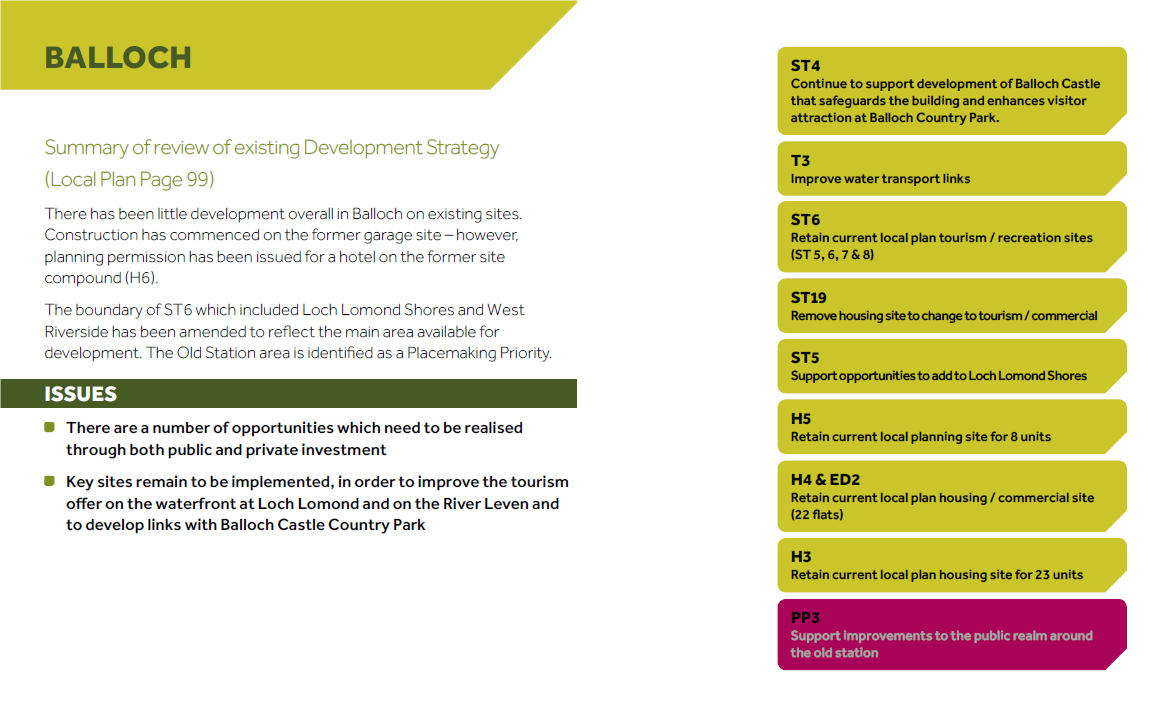
In these circumstances the only responses are likely to come from organisations with an interest to protect – hence all the comments from other public agencies and the Steamship Company.
The wider problem is that it was totally unclear what the proposed allocation of land at the Riverside Site and Woodbank House as “ST” might entail. The symbols and abbreviations were not explained. Does the camera symbol suggest a leisure complex and waterpark might be proposed here? Having worked out ST means “sustainable tourism” there is nothing in the glossary of terms or anywhere else in the three Main Issues Report documents, if you can be bothered to wade through them, to explain what this means. Given this label was attached to what are currently predominantly green areas, including parts of Balloch Country Park, and used the term “sustainable”, most people reading this will have assumed only minor developments were being proposed.
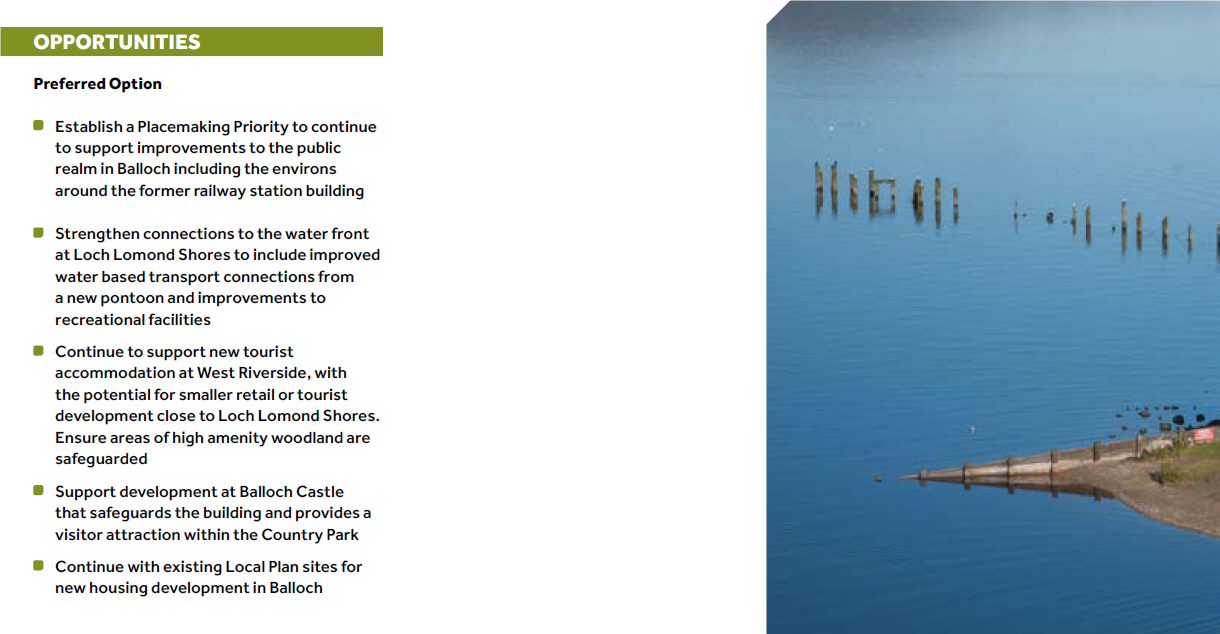
This would have been re-inforced by what little text there was in the Main Issues Report referring to the “potential for smaller retail or tourist development” at West Riverside. Who could have guessed Flamingo Land from that?
The Loch Lomond Steamship Company, to their credit, hinted at the issue when in their response they suggested that perhaps an “outline of what could go on these sites” should go into the plan:

The LLTNPA never took up the suggestion but appear to have been working behind the scenes with Scottish Enterprise to deliver a major development. At best the wording of the Main Issues Report was economical with the truth.
There is something fundamentally wrong here. When land is allocated for housing people have a basic idea of what this means and because of this do respond when concerned. But the LLTNPA’s allocation of land for Sustainable Tourism – which then transmogrified into “Visitor Experience” – is so broad as to be meaningless and thus in planning terms useless as far as the public are concerned.
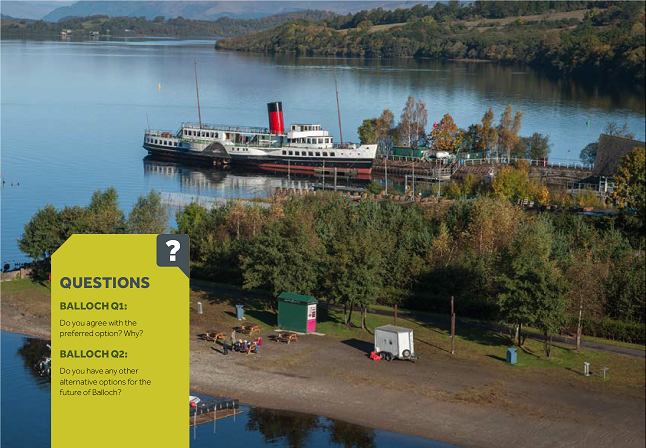
Given the lack of meaningful content, its hardly surprising hardly anyone responded to the two questions (see above) the LLTNPA asked about Balloch in the Main Issues Report. What should be evident now with c35,000 objections to the Flamingo Planning Application is that the LLTNPA failed to consult properly on the main issue facing the area and indeed the single most important issue now facing the LLTNPA Board. And they received a planning award for that.
The draft Local Development Plan consultation and Flamingo Land
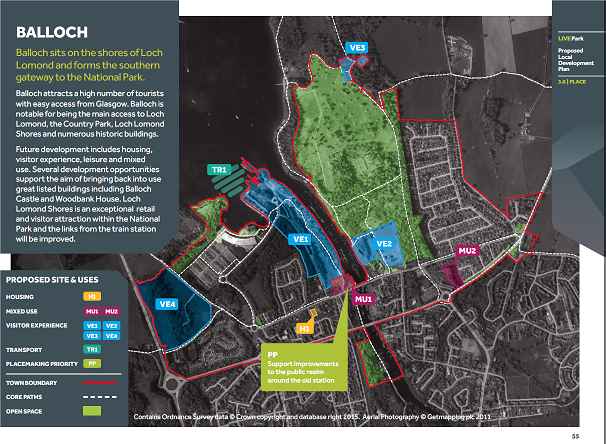
Having considered the responses to the Main Issues Report – there were 131 people or organisations who responded in total – the LLTNPA then issued its Local Development Plan for consultation. This included a number of changes for Balloch: the addition of a settlement boundary, the removal of a couple of sites that had been proposed for housing and the removal of ST 19 formerly proposed for Sustainable Tourism. The area shaded green for Transport just outside the Drumkinnon lagoon still did not include Balloch Pier or Maid of the Loch despite the representations from the Steamship Company. The ST label had been replaced by VE label, standing for Visitor Experience, but there was still nothing in the LDP consultation document which clearly set out what this might entail. Ominously the “small activity or retail businesses” label which had previously been attached to the land where Flamingo Land is now proposing to build its resort had been removed. Why?
The fundamental failure of the Main Issues Report, which was to give people a good idea of what actually be being proposed, was continued in the Local Development Plan.
It is hardly surprising therefore that the LLTNPA only received three objections relating to the Riverside Site.

The first, which concerns Drumkinnon Wood was wrongly summarised by the LLTNPA as the verbatim version of Ms Stewart’s response made clear:
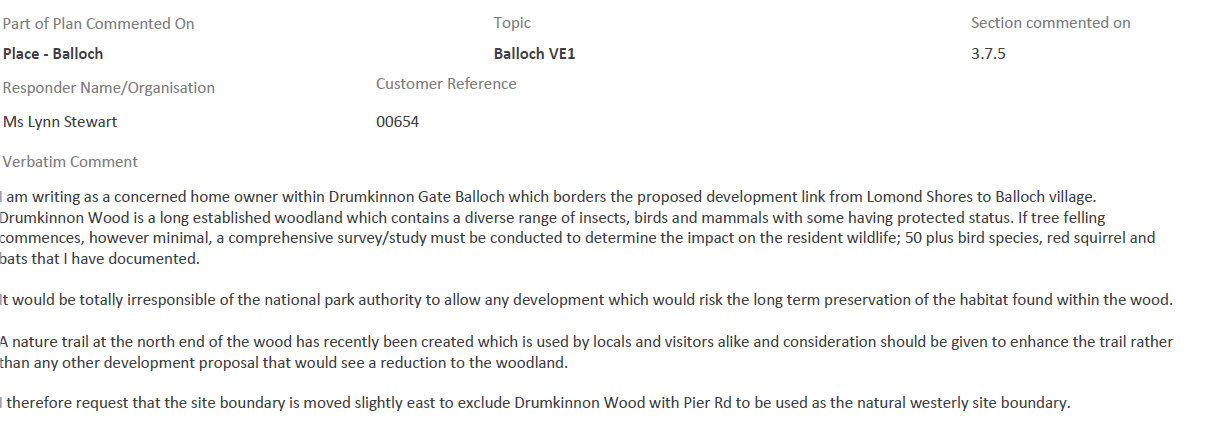
What Ms Stewart (whom I do not know) was drawing attention to was that the boundary of the Riverside Site had been drawn to include part of Drumkinnon Wood when it should have been drawn along Pier Rd.
Astonishingly, having failed to comment on the Main Issues Report, Scottish Enterprise at this late stage tried to get the whole of Drumkinnon Wood earmarked for “Visitor Experience”. Its hard to avoid the impression that this was a deliberate attempt to avoid any proper consultation with the public and to try and get the development into the Local Development Plan by the backdoor. For example, the Woodland Trust had responded to the proposals for both Woodbank House (ST5) and Balloch Country Park (ST8) in the Main Issues Report saying that ancient woodland on these sites must be protected (ie they should remain green). They never said anything about Drumkinnon Woods (between ST6 and ST 19 on the Main Issues Map) because it appeared outwith any area being proposed for development.
The SSE proposal contravened all normal planning protocols and the LLTNPA, who was supposed to be working in partnership with them, recommended it be rejected.
The LLTNPA however also rejected Lynn Stewart’s proposal to redraw the boundary of the West Riverside Site leaving a Trojan horse for Scottish Enterprise and Flamingo Land to include Drumkinnon Wood in their current Planning Application.
The Reporter, while endorsing the LLTNPA’s rejection of Scottish Enterprise’s proposal to include the WHOLE of Drumkinnon Woods in the plan, considered that the LLTNPA’s policies to protect trees would be sufficient to protect Drumkinnon Woods and so also rejected Lynn Stewart’s proposal to redraw the site boundary:
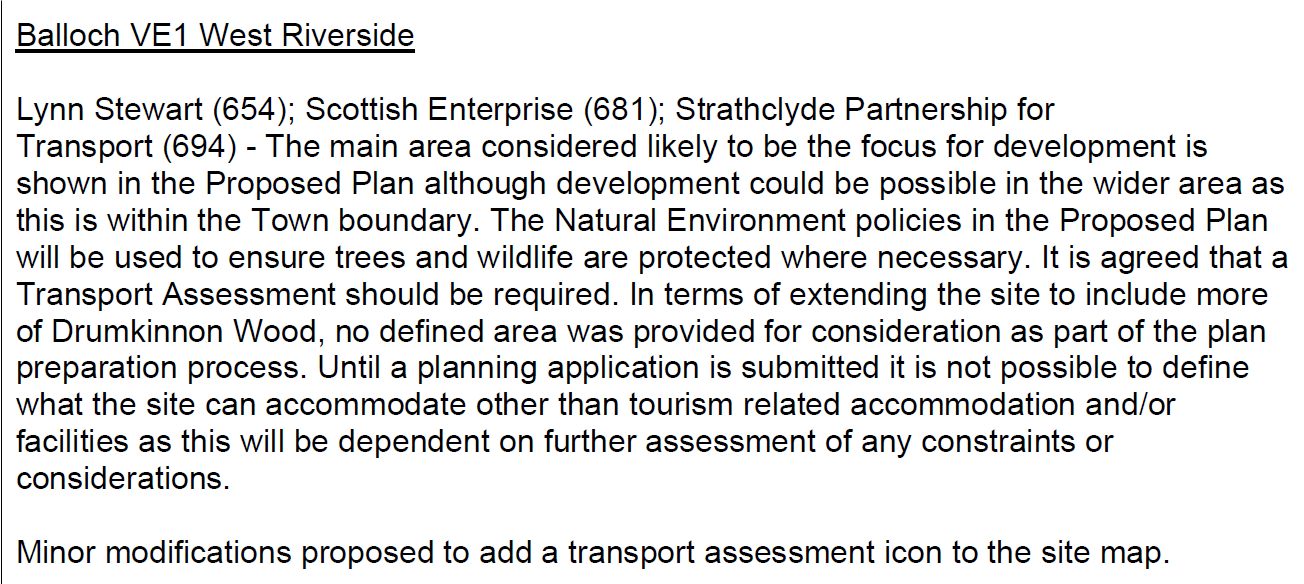
At the end of this sorry sage there was just one change to the LDP for Balloch, the attachment of a further transport icon to the map, something that doesn’t appear to have been done:
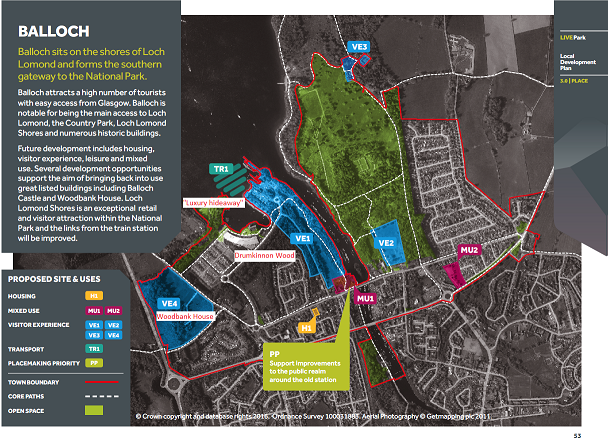
It is interesting to consider whether the same Reporter, on reading the 35,000 current objections to the Riverside development, would still reach the same conclusions. At the time s/he could only respond to the information presented and its clear now that was very limited- another failure in our planning system.
In case you are thinking this whole process was an accidental foul up, consider these extracts from Staff reports to the Board on the process:
“The investment of significant time and resources in early engagement to help inform the preparation and content of the Main Issues Report, through our programme of charrette events and workshops, has delivered several demonstrable benefits, most notably fewer responses when compared to the past Local Plan consultation and a smaller number of contentious issues or sites. (Board Report on Main Issues consultation 2014)”
Leave aside the fact that the charrette for Balloch took place AFTER the LDP had been approved, what comes through here is that staff saw fewer responses and an absence of contention as a sign of success. Here’s more:
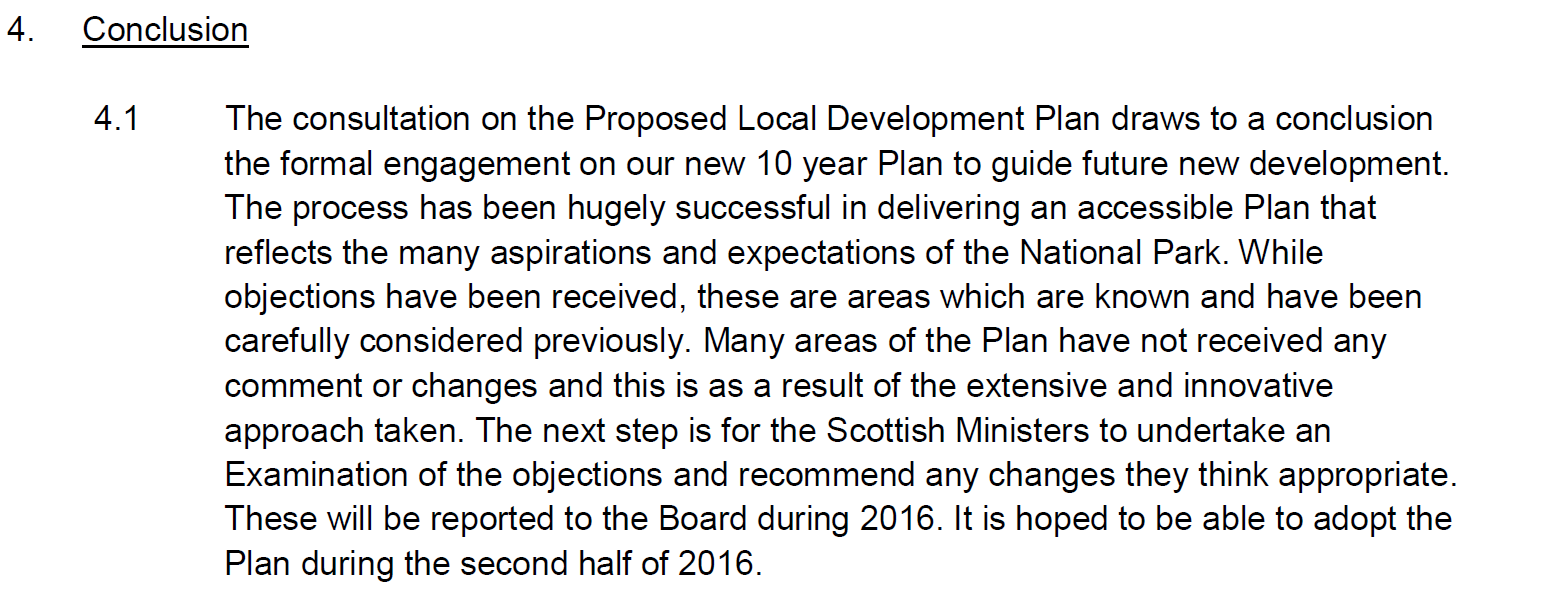
Actually, what should now be evident is that the LDP was an outcome of the LLTNPA’s failure to consult properly – exactly the same failures as took place with the camping byelaws – and there are now c35,000 objections to prove it.
What should our politicians learn from this failure to consult people about the main issues?
Aside from the failure of the LLTNPA to engage and consult properly on the real issues facing Balloch, there are some wider lessons here for the planning system.
People won’t respond to plans unless they are given a very clear idea of what is being proposed. Putting labels such as ST or VE on maps, which could indicate anything from Blackpool Tower to a hut in the woods, is worse than useless as a means of engaging people. The fundamental issue is that owners of land designated for development have ideas in their heads of what they would like but at present this information is kept from the public. Had Scottish Enterprise had to declare as part of the Main Issues Report that it wanted to develop Drumkinnon Woods, the scale of the development it was envisaging for the Riverside site or that this could include Loch Lomond’s very own version of the Blackpool tower (dropped before the Planning Application was submitted) then far more people might have responded.
However, even if Planning Authorities highlighted rather than tried to cover up and avoid issues, it seems unlikely the whole of the Planning System can be “frontloaded” as the Scottish Government would like. (The Government’s hope being that contentious issues can be sorted out at the plan stage and that planning applications when submitted can be dealt with quickly). People need time to understand, debate and come to views about proposals and as they do there needs to be time and processes for further engagement. In theory, with the community empowerment legislation, there could now be mechanisms to do this. However, to date, neither the LLTNPA nor Scottish Enterprise have shown much sign of wanting to engage in meaningful discussion with either the local community or the wider public.
Which raises another major question for politicians, how should Planning Authorities consult and engage on aspects of Local Development Plans which have not just local but national significance? Besides failing to engage properly with local people, the LLTNPA totally failed to anticipate the interest the application would raise nationally. This despite having labelled Balloch as the tourism gateway to the National Park.
People really care not just about our National Parks but the wider natural and cultural heritage. Our politicians need to ensure that the planning system is both designed and operated in way that meets the aspirations of the public instead of putting developers first. The way the LLTNPA development plan process has been handled at Balloch provides a classic example of how not to do this.

To misquote the Duke of Wellington we appear to have lies, damned lies, and Main Issue Reports. I’m concerned about planning front loading when this is how public bodies carry on .. where are the checks and balances to give confidence in front loading? The public bodies clearly can’t be trusted to consider all stakeholders… Meaning the public not just buisness and those we elect.